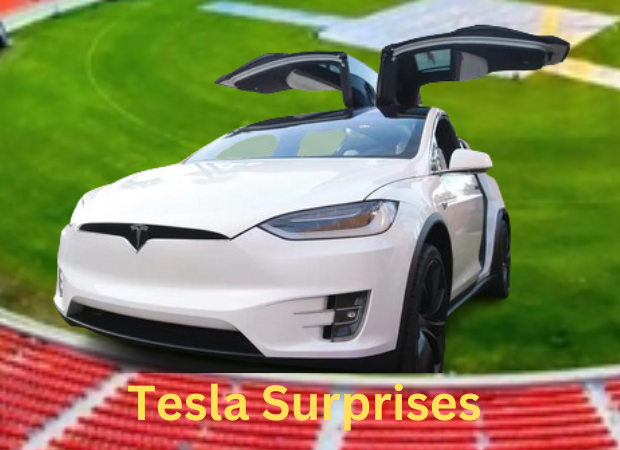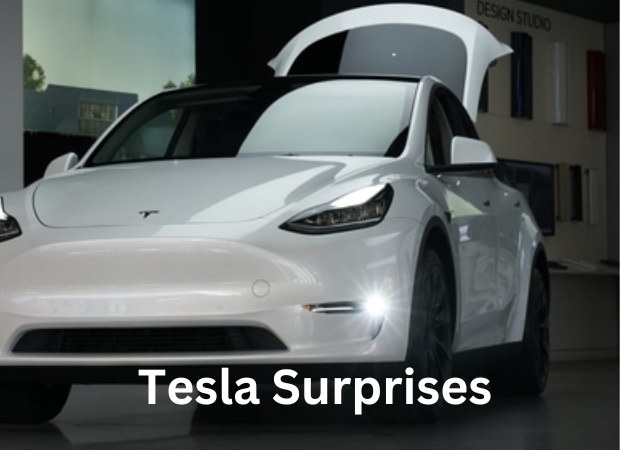Tesla’s announcement today has sent shockwaves through the industry, signaling a departure from the singular focus on robotaxis. With the revelation that Tesla will indeed venture into the compact car market, questions arise about who will step up to challenge the status quo. Previously dubbed the Model 2, this next-generation compact car has garnered significant attention, including a recent insightful article by Zach.
Tesla’s decision underscores a simple reality: if Toyota can produce the Corolla and Ford can craft the Fiesta, there’s no reason why Tesla, armed with its formidable talent pool, cannot engineer a smaller electric vehicle. Despite initial speculation about Elon Musk’s steadfast commitment to robotaxis, the company’s pivot reflects a pragmatic response to stalled sales and the imperative to appease investors. By introducing a vehicle priced approximately $10,000 less than the Model 3 and Model Y, Tesla aims to capture a broader market and sustain investor confidence.

The Future of Tesla: Steering Towards Full Self-Driving
If Full Self-Driving (FSD) works as quickly as Elon thinks, these new models may be the last cars Tesla introduces with a steering wheel. However, if they encounter issues, whether technical or regulatory (as speculated about in this article last year), Tesla has made it clear that they still aim to realize all the dramatic cost savings enabled by their Unboxed method, detailed a year ago at Investor Day. The robotaxi announcement slated for August 8th of this year further emphasizes Tesla’s commitment to achieving these goals. They have also stated their intention to achieve significant cost savings on future low-cost vehicles, either this year or early next year, without requiring the radical new manufacturing space and massive capital that would be needed to build it.
Navigating Osborne Effect: Balancing Innovation and Existing Sales
To avoid the Osborne Effect and maintain the appeal of existing models while introducing the new Tiny lineup, Tesla must carefully navigate the delicate balance between innovation and preserving current sales. One approach is to strategically implement features that differentiate the new vehicles without overshadowing the existing lineup.
While it’s crucial not to compromise the success of the new models, certain cost-saving measures can be employed to achieve this balance. For instance, Tesla could consider using slightly lower-grade materials or offering fewer advanced features in the Tiny lineup compared to the existing vehicles. By doing so, Tesla can position the new models as more affordable options without diminishing the overall appeal of their product range. This strategic approach allows Tesla to capture a wider market segment while safeguarding the sales and reputation of their existing lineup.

- Opting for significantly shorter and narrower dimensions for the new Tiny lineup presents a pragmatic approach to reducing material costs and enhancing efficiency. By leveraging the insight that height can be traded for length without compromising interior space, Tesla can maintain functionality while achieving substantial savings. Drawing inspiration from successful compact models like the Wuling Mini EV and the BYD Seagull, which prioritize vertical space efficiency, Tesla can design vehicles that offer a more upright seating position. This design tweak not only minimizes material usage but also contributes to a lower center of gravity, ensuring stability despite the reduced dimensions. While this approach may result in a slightly unconventional appearance, it strategically positions the new models in a distinct market segment, akin to Apple’s strategy of offering different price points within a simplified product line.
- Utilizing smaller wheels for the new Tiny lineup is a practical measure that aligns with Tesla’s cost-saving objectives. Despite their crucial role, tires often receive less attention compared to batteries, yet they can substantially impact overall vehicle expenses. As evidenced by recent personal expenditures, tire replacement costs for models like the Model Y can be significant. By opting for smaller wheels, Tesla can not only reduce initial manufacturing costs but also potentially mitigate long-term maintenance expenses for owners. This strategic decision underscores Tesla’s commitment to maximizing cost efficiency across all aspects of vehicle production and ownership.
- Implementing the $1,000 motor unveiled at Investor Day a year ago is a pivotal step towards cost reduction in the new Tiny lineup. With traditional motors costing up to two to three times more, this innovative motor offers a significant opportunity for savings without compromising performance. By leveraging advanced engineering and manufacturing techniques, Tesla can achieve unprecedented affordability while maintaining the high standards of efficiency and power associated with their vehicles. This strategic utilization of cost-effective motor technology exemplifies Tesla’s commitment to pushing the boundaries of innovation and accessibility in the electric vehicle market.
- Integrating lower-cost batteries, such as lithium iron phosphate (LFP) or potentially sodium-based batteries in the future, presents a promising avenue for cost reduction in the new Tiny lineup. By leveraging alternative battery chemistries known for their affordability, Tesla can further drive down production costs while maintaining essential performance metrics. LFP batteries, in particular, offer a compelling balance between cost-effectiveness and durability, making them an attractive option for mass-market electric vehicles. Looking ahead, advancements in sodium-based battery technology hold promise for even greater cost efficiencies in the long term. By embracing these innovations, Tesla can enhance the accessibility of electric vehicles to a broader audience while reinforcing its commitment to sustainable transportation.
- Designing a model with 200 miles of range addresses the practical needs of cost-conscious buyers who prioritize affordability and everyday usability. While some consumers may require vehicles with greater range for longer trips, a 200-mile range is sufficient for many daily commuting and errand-running needs, especially in regions with plentiful fast charging infrastructure. By focusing on this range threshold, Tesla can optimize battery size and vehicle weight to achieve a balance between cost-effectiveness and functionality. This approach not only caters to consumers seeking a second car or a primary vehicle for urban use but also aligns with Tesla’s commitment to expanding electric vehicle adoption by offering models tailored to diverse market segments.
- Implementing the 48V vehicle architecture pioneered by the Cybertruck presents a revolutionary opportunity to significantly reduce wiring costs by up to 75% in the new Tiny lineup. This innovative approach streamlines electrical systems by utilizing lower voltage throughout the vehicle, minimizing the need for heavy, expensive copper wiring. By adopting this architecture, Tesla can achieve substantial cost savings while enhancing overall efficiency and reliability. The Cybertruck’s success in showcasing the feasibility and benefits of 48V architecture underscores its potential to revolutionize electric vehicle design across various models, including smaller, more affordable options like the Tiny lineup. This strategic move aligns with Tesla’s commitment to advancing technological innovation and driving down production costs, further solidifying its position as a leader in the electric vehicle market.
- By employing drive-by-wire, accelerate-by-wire, and brake-by-wire systems, Tesla can minimize design disparities between left-hand drive (LHD) and right-hand drive (RHD) markets in the new Tiny lineup. These advanced technologies replace traditional mechanical linkages with electronic controls, offering greater flexibility in vehicle design and manufacturing. With drive-by-wire, the steering mechanism becomes electronically controlled, eliminating the need for different steering components for LHD and RHD configurations. Similarly, accelerate-by-wire and brake-by-wire systems enable standardized pedal layouts regardless of the vehicle’s orientation on the road, simplifying production processes and reducing costs associated with manufacturing variations. This harmonization of design elements not only enhances manufacturing efficiency but also facilitates Tesla’s expansion into diverse global markets with minimal adaptation requirements, ultimately driving down production costs and increasing accessibility for consumers worldwide.
- Designing the new Tiny lineup with framed doors, akin to those found in many inexpensive cars, offers a pragmatic approach to reducing costs while enhancing simplicity and safety. Framed doors are typically less expensive to manufacture and easier to fit compared to frameless designs, making them ideal for a budget-friendly vehicle. Additionally, framed doors provide increased structural rigidity, potentially enhancing safety in the event of a collision. By embracing this design choice, Tesla can streamline production processes and reduce assembly complexity, ultimately contributing to lower overall manufacturing costs without compromising on safety or functionality. This strategic decision aligns with Tesla’s commitment to innovation and affordability, reinforcing its position as a leader in the electric vehicle market.
- Fully utilizing existing manufacturing plants represents a strategic opportunity for Tesla to realize economies of scale and capitalize on operational efficiencies in producing the new Tiny lineup. By maximizing the output of current facilities, Tesla can spread fixed costs over a larger volume of vehicles, reducing per-unit production costs and increasing profitability. Additionally, leveraging existing infrastructure minimizes the need for significant capital investment in building new manufacturing plants, saving both time and resources. This approach allows Tesla to streamline production processes, optimize supply chain logistics, and enhance overall operational efficiency. By harnessing the potential of their established manufacturing footprint, Tesla can accelerate production timelines, meet growing market demand, and maintain a competitive edge in the electric vehicle industry.
Conclusion
Tesla’s ambition to halve the cost of vehicles like the Model 3 and Model Y to approximately $16,000 per vehicle remains a significant goal, albeit challenging to achieve immediately. However, by implementing cost-saving measures such as those speculated above, including leveraging new technologies, optimizing manufacturing processes, and utilizing existing infrastructure, Tesla could realistically achieve a $10,000 reduction in costs. This would bring the cost per vehicle down to around $22,000, enabling Tesla to offer the new Tiny lineup at a price point of $25,000 with a modest 12% margin. While this margin may seem slim, Tesla’s strategy revolves around monetizing software and services rather than hardware alone. Furthermore, aggressive pricing for smaller vehicles is a common strategy across the automotive industry, aiming to attract new customers to the brand and establish long-term relationships. By offering a competitively priced electric vehicle with compelling features and performance, Tesla can further solidify its position as a leader in the electric vehicle market and accelerate the transition to sustainable transportation. more info